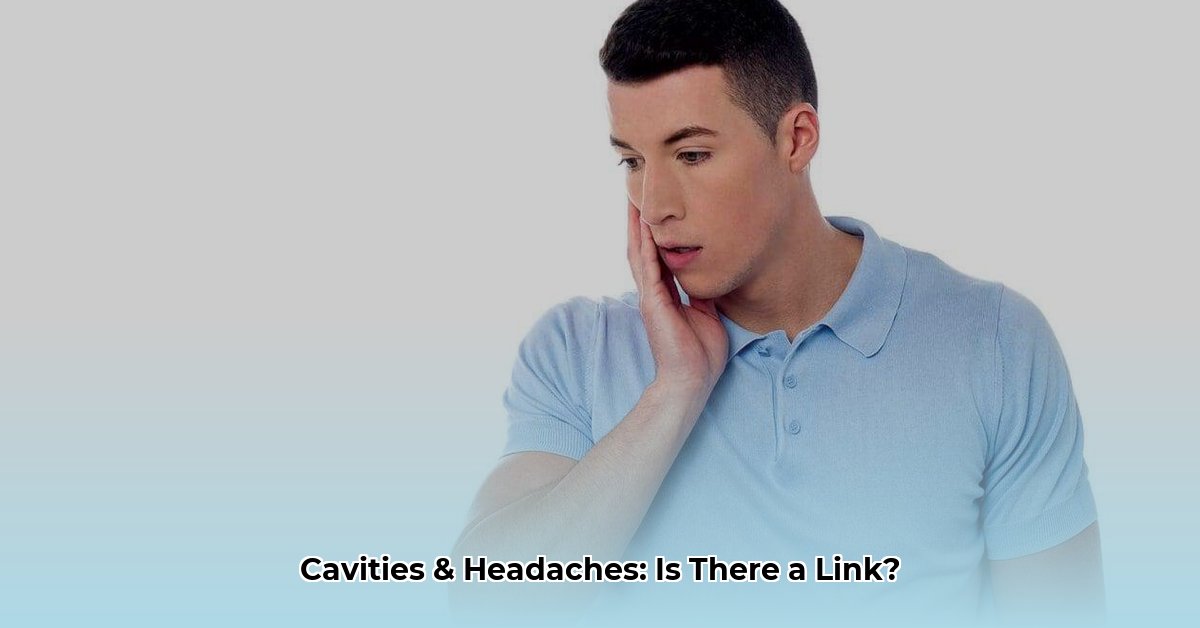A throbbing headache combined with tooth pain can be concerning. While a cavity doesn’t directly cause a headache, advanced decay or infection can lead to referred pain perceived as a headache. This article explains the connection between tooth pain and headaches, outlining what to do if you suspect a cavity is the culprit.
Understanding Cavity-Related Headaches
How Cavities Develop
Cavities form when bacteria in your mouth produce acids that erode tooth enamel. Initially, a cavity may be small and painless. However, as decay progresses, it penetrates the dentin, the softer layer beneath enamel, potentially causing sensitivity to hot or cold. If left untreated, the decay reaches the pulp, the tooth’s inner chamber containing nerves and blood vessels, leading to significant pain.
The Trigeminal Nerve and Referred Pain
The trigeminal nerve plays a crucial role in transmitting sensations from your face, jaw, and teeth to your brain. When a tooth is severely decayed or infected, it irritates the trigeminal nerve. Sometimes, the brain misinterprets the source of this pain signal, perceiving it as originating in other areas served by the trigeminal nerve, such as the head. This phenomenon is called referred pain, explaining how a toothache can manifest as a headache, often focused around the temples, ears, or jaw on the affected side.
(Insert diagram of the trigeminal nerve highlighting its connections to the teeth and head regions)
Identifying a Cavity-Related Headache
Distinguishing Symptoms
Pinpointing the cause of a headache can be challenging. Here’s how to differentiate a cavity-related headache from other common types:
-
Cavity-Related Headache: Throbbing pain localized near the affected tooth, often worsening when chewing. Accompanying symptoms may include tooth sensitivity, jaw stiffness, ear pressure, or even a slight earache on the same side.
-
Tension Headache: Characterized by a tight band-like pressure around the head, often related to stress, muscle tension, or fatigue. Tooth pain, jaw stiffness, or earaches are typically absent.
-
Sinus Headache: Pain and pressure concentrated in the forehead, cheekbones, and the bridge of the nose, often accompanied by nasal congestion and a runny nose. This type of headache is usually related to sinus issues, not dental problems.
-
Migraine: An intense, often debilitating headache that typically throbs on one side of the head. Migraines can be accompanied by nausea, vomiting, and sensitivity to light and sound. While a severe toothache might trigger a migraine in some individuals, a cavity-related headache usually centers around the affected tooth and jaw.
This table summarizes key differences:
| Headache Type | Location of Pain | Other Symptoms |
|---|---|---|
| Cavity-Related | Same side as affected tooth | Tooth sensitivity, jaw stiffness, ear pressure |
| Tension | Band-like pressure around head | Often related to stress, muscle tension |
| Sinus | Forehead, cheekbones, nose | Nasal congestion, runny nose |
| Migraine | Typically one side of head | Nausea, vomiting, light sensitivity |
While less common, serious conditions like brain infections can also cause headaches. Any severe, persistent headache, especially with accompanying symptoms like fever, stiff neck, vision changes, or altered mental state, warrants immediate medical attention.
What to Do if You Suspect a Cavity-Related Headache
If you think a cavity is causing your headache, contact your dentist promptly. Early intervention is crucial. Here’s what to do:
- Schedule an Appointment: Don’t delay. Prompt treatment can prevent further complications.
- Describe Your Symptoms: Provide your dentist with a detailed account of your symptoms, including the location and type of pain, as well as any accompanying issues like tooth sensitivity, swelling, or fever.
- Follow Your Dentist’s Recommendations: Your dentist will likely examine your teeth and may recommend X-rays to diagnose the problem accurately. Follow their prescribed treatment plan carefully.
- Temporary Pain Relief: Over-the-counter pain relievers like ibuprofen or acetaminophen can offer temporary relief while you await your dental appointment. Remember, these medications only mask symptoms and don’t address the underlying issue. Never attempt to self-treat a suspected cavity.
Preventing Cavities and Related Headaches
Preventing cavities is the most effective way to avoid cavity-related headaches. Adopt these oral hygiene practices:
- Brushing: Brush twice daily for two minutes using fluoride toothpaste and a soft-bristled brush.
- Flossing: Floss daily to remove food particles and plaque from between your teeth.
- Regular Dental Checkups: Schedule professional cleanings and checkups every six months. Regular visits allow your dentist to detect and address potential problems early, preventing them from escalating.
- Diet: Limit sugary drinks and snacks, as they contribute to cavity formation.
Finding a Dentist
Prioritizing your oral health is essential. If you need to find a dentist, resources like the American Dental Association can help you locate a qualified professional in your area.
Ongoing Research
Research continues to explore the complex relationship between dental issues and headaches. While the current understanding suggests a strong link, ongoing studies delve into the intricacies of pain perception, the interplay of nerves in the head and neck region, and the mechanisms by which tooth pulp inflammation can trigger headaches. As research progresses, our understanding of this connection will likely evolve.
Disclaimer: This information is for educational purposes only and does not constitute medical advice. Always consult a qualified healthcare professional for any health concerns or before making any decisions related to your health or treatment.
- Bento Box Trays Streamline Restaurant Meal Presentation and Transport - December 13, 2025
- Plastic Bento Boxes Face Scrutiny Over Sustainability Impacts - December 11, 2025
- Bento Tray Revolutionizes Organized Meal Transport and Presentation - December 10, 2025










